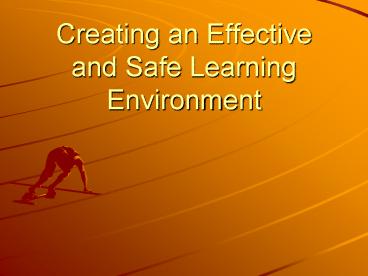Creating an Effective and Safe Learning Environment - PowerPoint PPT Presentation
1 / 34
Title:
Creating an Effective and Safe Learning Environment
Description:
Creating an Effective and Safe Learning Environment Creating an Effective and Safe Learning Environment Revisiting instructional principles Rules, routines and ... – PowerPoint PPT presentation
Number of Views:2642
Avg rating:3.0/5.0
Title: Creating an Effective and Safe Learning Environment
1
Creating an Effective and Safe Learning
Environment
2
Creating an Effective and Safe Learning
Environment
- Revisiting instructional principles
- Rules, routines and discipline
- Feeling safe
3
Revisiting Instructional Principles
- Appropriate and interesting activities
- Sequencing of activities/ Short transition
between activities - Organisation of equipment and groups
- Use of voice and whistle
- Demonstration and explanation of activities
- Useful feedback positive reinforcement and
encouragement - Enthusiasm / confidence
- Positioning / movement around the group
4
Appropriate and Interesting Activities
- Level age, skill, developmental
- Outcome
- Environment
- Group number
- Variety
5
Sequencing of activities
- Planning
- Short transition between activities
- Progressive
- Flow
6
Organisation of Equipment and Groups
- Planning
- Pre check equipment
- Safety
- All there
- Positioning of equipment
- Safety
- Keep eyes on group
7
Organisation of Equipment and Groups cont.
- Group formation strategies
- off
- Cuddles
- Football teams etc
- Use previous activity to choose even teams
- Ability buddy
- Never, never, never let captains choose teams
8
Organisation of equipment and groups cont.
- Safety
- Plan for a safe working
- environment
- Distance between groups
- Supervision
- No interference
- Direction of play
- Dangerous activities
- Throwing, batting, archery
9
Use of voice and whistle
- Whistle
- Safety
- Stop not start
- Loud honk
- Voice
- Vary
- Protect
10
Demonstration of activities
- A picture paints a thousand words
- Correct technique YOU practice
- Use student or dry run
- Check with student first
- Ensure all can see
- Support with TP
11
Explanations of Activities
- Wait for attention
- Clear and concise
- Limit to 5 points
- Concentrate on
- most important
- Add others later
12
Feedback Positive reinforcement or
encouragement?
- Positive reinforcement
- specific teachable moment
- Encouragement
- general comment to improve self esteem and
effort
13
Positive reinforcement
- Focuses on the learning outcome
- Set a task and tell students you are coming to
look at one thing - Must be accurate and consistent
- Formative enhances learning
14
Positive Reinforcement cont.
- If advice is given, stay
- with the student
- Get students to provide
- feedback for each other
- Criteria sheets
15
Encouragement
- Does little to reinforce learning
- Develops enthusiasm and self esteem
- What we do well
- Keeps our presence known
- Keeps students on track
16
Negative Feedback
- Giving attention on what is not to be done
confusion - No put downs or sarcasm - negative effect for most
17
Enthusiasm and Confidence
- Grows with experience
- Planning helps
- Know yourself and your style
- Teach on the stage
- Students are perceptive
- Low on enthusiasm Why?
18
Positioning and Movement Around the Group
- You can see all, and
- all can see you
- Varies
- Whole group instructions
- Small group activity
- Whole group game
- Supervising non-
- participants
- MOVE!
19
Feeling Safe
- Learning requires taking risks
- A learning environment needs to be safe to ensure
effective and optimal learning occurs - Physical
- Emotional
- Social
20
Emotional Safety
- Self efficacy
- Environment free
- of putdowns
- Based on mutual
- respect and trust
21
Social Safety
- Inclusion not exclusion
- Dont single out or exhibit students
- Opportunity to mix social groups
- Look out for the isolate
- Strategies for inclusion?
22
(No Transcript)
23
Rules, Routines and Discipline
- Often go hand in hand
- For safety and efficiency
- Need to reflect PE department, school, State and
society
24
Rules
- Often called policies
- List all the areas where rules are needed in a PE
class situation
25
Rules cont.
- Changing
- Participation
- Equipment use
- Access to store rooms
- Excursions
- Treating others with respect
- Selection in sports teams
- Games
26
Routines
- Procedures to ensure the safe and efficient
running of the class - List all the areas where routines are needed to
ensure the smooth running of PE class.
27
Routines cont.
- Students lining up
- Entering the gym
- Changing / supervision?
- Marking the roll
- Carrying equipment
28
Routines cont.
- Moving around the school
- Going on excursions
- Distribution of equipment
- Drink breaks / supervision?
- Student helpers - jobs
29
Disciplining Students
- Know what is, and isnt acceptable
- To you
- To the school
- To the school community
- Consistent
- Flexible
- Proactive not reactive
- Relevant consequence
30
Discipline Plan
- Progressions
- Consequences
- Rewards
31
Discipline Plan cont.
- Write your own discipline plan
- Compare it to the discipline plan in your school
during Schools Experience - If possible, implement your discipline plan,
reflect and review
32
Today is the first day of the rest of your life
(Kahal Gibran)So better make it a good one!
33
References
- Capel, S. Learning to Teach Physical Education in
the Secondary School A Companion to School
Experience. (2nd ed.). London Routledge. - Harrison,J., Blakemore, C. and Buck, M. (2001).
Instructional Strategies for Secondary School
Physical Education. (5th ed.) NY McGraw-Hill
Higher Education.
34
Reading
- Chapter 27 Considerations in management and class
control in PE settings - Tinning, R., McGuaig, L., and Hunter, Ll.
Teaching Health and Physical Education in
Australian Schools. NSW, Australia Pearson
Education Australia, 2006.































